Step back in time with the pocket watch, discover styles, history, how to wear one today, and why this timeless accessory still makes a bold statement in modern fashion.
A pocket watch speaks to more than just time; it reflects the taste, tradition, and craftsmanship every gentleman appreciates.
While wristwatches dominate modern men’s fashion, the pocket watch still holds a place of honor for gentlemen who value detail and heritage.
From formal events to heirloom collections, it adds a refined touch that few contemporary accessories can match.
The chain, the feel in a gentleman’s palm, the quiet tick, all carry a sense of ritual that wristwatches simply cannot replicate.
Unlike wristwatches, which often blend into daily wear, a pocket watch makes a deliberate statement.
It’s worn with intention, tucked away with care, and revealed with purpose.
This subtle charm and connection to the past continue to captivate discerning men, collectors, and traditionalists alike.
For men drawn to distinction, the pocket watch may be the perfect companion.
VISIT POCKET WATCH MARKETPLACE

Table of Contents
- Main Points
- What is a Pocket Watch?
- The History of Pocket Watches
- Types of Pocket Watches You Should Know
- Pocket Watch Mechanisms and Movements
- Key Features and Components
- How to Wear and Use a Pocket Watch
- Collecting Pocket Watches
- Maintenance and Care
- Frequently Asked Questions
- Conclusion
Main Points
- Pocket watches originated in the 1500s, evolving from large pendants to precise, smaller timepieces symbolizing gentlemen’s status and craftsmanship.
- Mechanical and quartz movements define pocket watches; mechanical offers tradition and hands-on care, while quartz provides accuracy and low maintenance.
- Different styles like open face, hunter, and skeleton watches offer varied protection, visibility, and design, catering to personal taste and function.
- Wearing a pocket watch today adds intentional style, pairing perfectly with formalwear or vintage fashion, connecting wearers to tradition and elegance.
What is a Pocket Watch?
A pocket watch, also known as a fob watch or timepiece, is a classic accessory carried by gentlemen, not worn on the wrist. It’s kept tucked safely in a pocket, often clipped with a chain or fob, so men can easily grab it without worrying about losing it.
Some pocket watches have a cover that flips open, while others display the watch face at all times.
These timepieces run on either quartz or traditional mechanical movements. When a gentleman winds his watch by hand, he’s honoring a long-standing tradition.
Though its round design is simple, it draws the eye, especially when paired with a suit or waistcoat.
Many men wear one to weddings or pass it down as a treasured heirloom, preserving the stories and heritage that come with it.
Recommended: Older Men: Living Life to the Fullest
The History of Pocket Watches
You probably see a pocket watch as a vintage item, but it didn’t start that way.
It was once the height of timekeeping technology. Knowing its history can give you a deeper appreciation for what you’re holding, or thinking of buying.
Where It All Began: 16th to 18th Century
Pocket watches came into use in the 1500s, worn as pendants by the wealthy. Early designs were large, oval-shaped, and often unreliable.
But they represented a shift from public to personal time. Over the next two centuries, they evolved.
By the 1700s, watches became smaller and more accurate. Covers protected the dial, and minute hands made it more functional.
Watchmakers began crafting them with artistic detail and better materials.
If you were someone of means during this period, a pocket watch wasn’t just a tool, it was a status symbol you kept close and showed off with pride.
Recommended: Luxury Watches for Elite Gentlemen
The 1800s: A Watch in Every Pocket
In the 19th century, fob watches became more accessible. Mass production and better mechanics made them reliable and affordable.
You didn’t have to be rich to own one anymore. Every day, workers, businessmen, and even train conductors depended on them.
Railroads required strict timekeeping, so watches were checked for accuracy. Styles also changed.
You’d see men carrying them in vest pockets, attached with chains, as part of their daily dress.
Some had intricate cases, while others were simple and practical.
Pocket watches became part of how you showed your punctuality, reliability, and attention to personal presentation.
The Decline in the 1900s
By the early 20th century, pocket watches started to fade out of everyday use. Wars changed how people spent their time.
Soldiers needed quicker access, and wristwatches made more sense in the trenches. Soon, wristwatches became the norm.
If you were around then, you’d see fewer pocket watches outside of formal occasions.
The shift reflected a faster, more practical way of life. By mid-century, they were mostly passed down or used as dress accessories.
Pocket watches went from daily companions to keepsakes, still respected, but no longer required to manage your day.
Today’s Place: Collectibles and Legacy
Now, pocket timepieces speak more to your appreciation for tradition than timekeeping.
You might own one because it belonged to your grandfather or because you love mechanical craftsmanship.
Collectors seek rare brands, intricate engravings, and movements with history. You can still wear one today, especially for weddings or formal events.
They bring a touch of style and meaning that a digital watch never could. And if you’re into vintage fashion or horology, pocket watches offer a deeper connection to the past.
Their story lives on through those who still carry them, care for them, and pass them down.
Related Posts
- Guide to Men’s Dress Watches
- Cartier Men’s Wristwatches: Comprehensive Guide
- Gentlemen’s Fashion Accessories Guide
- Best Men’s Watches by Luxury, Occasion, Affordability, and Smartness
- Fashion Guide for Older Gentlemen
- Must-Have Wardrobe Essentials for Men Over 50
- The Older Gentleman: Class, Sophistication, and Etiquette
- Quality Men’s Watches Under $100 But Look Expensive
Types of Pocket Watches You Should Know
If you’re thinking about getting a pocket watch or already have one, it helps to know what type you’re dealing with.
Each kind has a purpose, and once you get familiar with the styles, you’ll know which one fits your taste or occasion best.
Open Face Pocket Watch
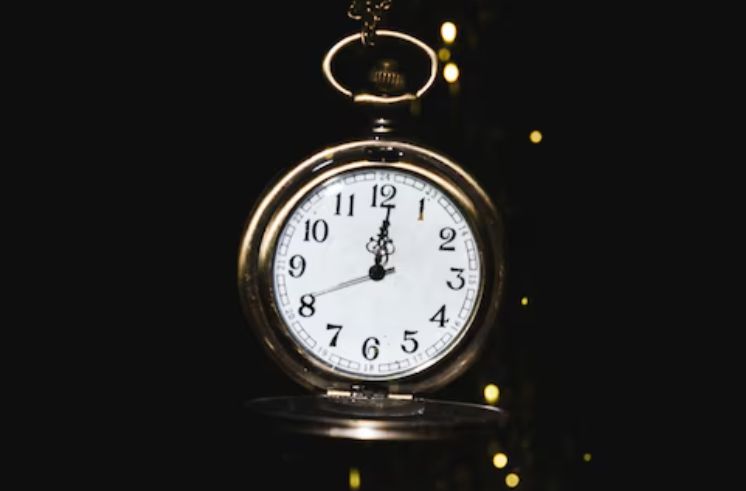
You get straight to the time with an open-face pocket watch. There’s no cover to flip, just the dial ready whenever you need it.
That simplicity is part of its charm. It’s handy if you check the time often and want something easy to carry.
It also slides in and out of your pocket without worrying about a hinge or button.
This type works well for both everyday use and formal settings.
If you prefer a watch that looks clean and feels ready when you are, the open face might be your go-to style.
Hunter Case Pocket Watch
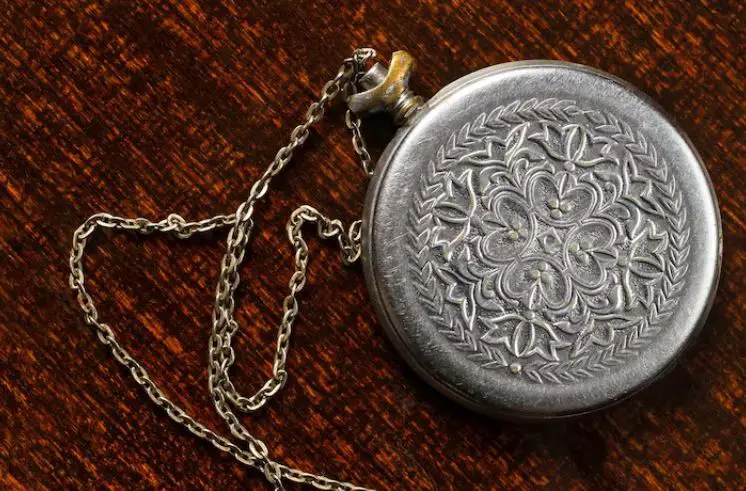
The hunter case gives your watch a lid that protects the dial until you press the crown to pop it open.
That flip feels satisfying and adds a small touch of drama when you check the time.
It also helps guard against scratches and dust, which is useful if you carry your watch daily.
These watches usually feel more traditional and formal. If you enjoy that extra bit of movement, click, flip, glance, this type keeps the experience fun without being fussy.
It’s a classic choice if you like your timepieces to feel like keepsakes.
Half Hunter Pocket Watch
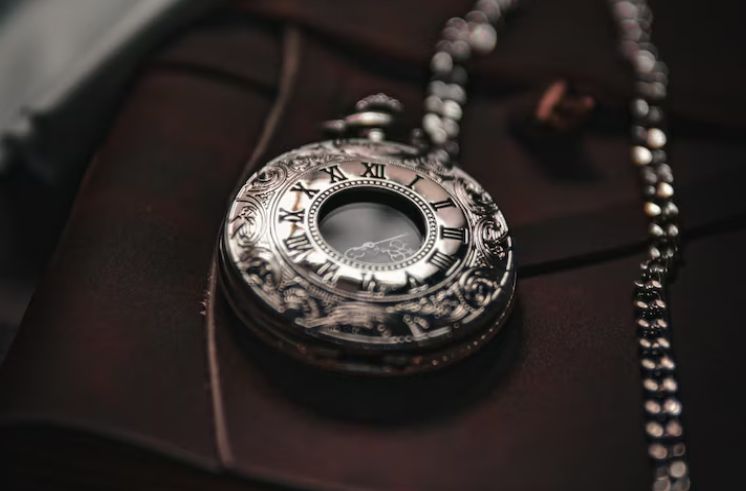
A half hunter case adds a small window on the cover, so you don’t have to flip it open to read the hands.
You get protection with a peek. This feature is helpful when you’re in a rush or checking the time on the move.
Many of these covers have Roman numerals or hour markers etched around the glass, letting you glance through and still know the time.
If you want both utility and a touch of old charm, this option finds the middle ground. It’s also a smart pick for anyone who values both form and function.
Double Hunter Pocket Watch
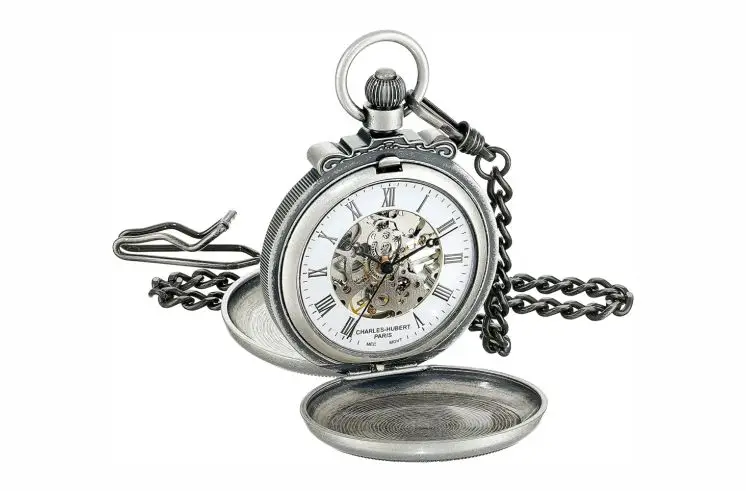
With a double hunter case, you get two lids, one at the front and one at the back.
This lets you open both sides and view the watch face and inner movement.
You’ll enjoy watching the gears tick, especially if you appreciate mechanical watches.
This type is made for those who love craftsmanship. It’s also great if you wear your watch with formal clothes or collect vintage timepieces.
The extra lid at the back turns your watch into a tiny showcase. If you like to see the full picture, this style offers more than just time.
Skeleton Pocket Watch
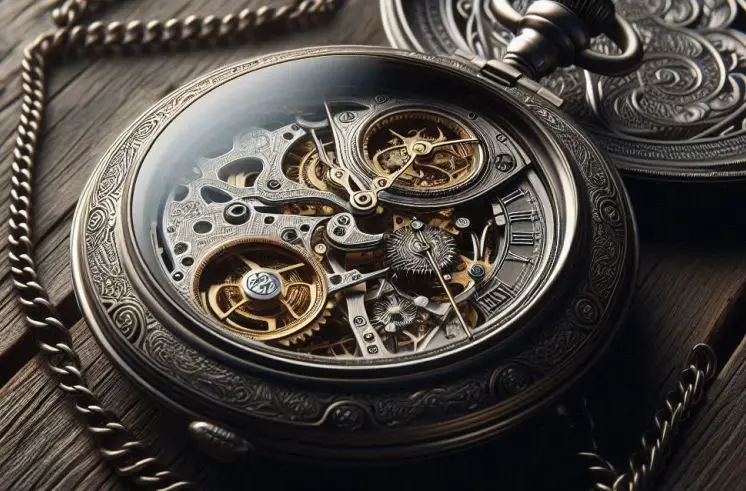
A skeleton pocket watch puts the movement on full display. Instead of hiding the gears, the face is transparent or cut out, so you can watch everything working as it keeps time. It’s mechanical art in your pocket.
You’ll probably find yourself staring at the gears turning as much as checking the hour.
If you’re someone who enjoys understanding how things work, this type speaks to that curiosity.
Skeleton watches are popular among collectors, especially the hand-wound kind. It’s not just about carrying time, it’s about carrying something alive with motion and detail.
Pocket Watch Mechanisms and Movements
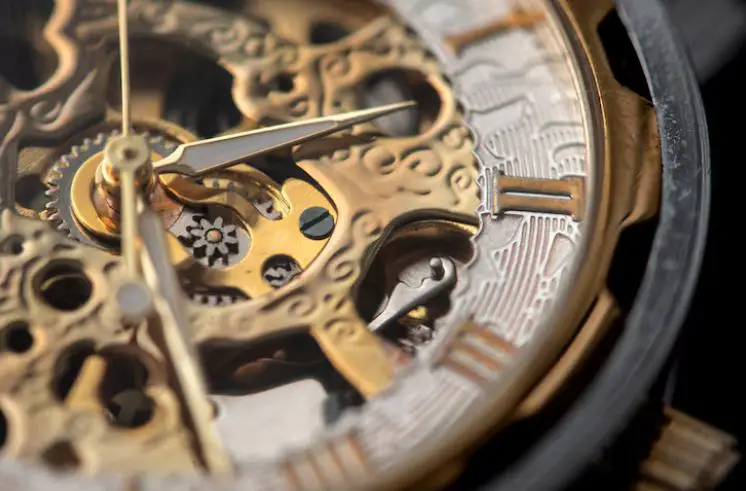
Understanding how a pocket watch works helps you take better care of it and choose the right one for your needs.
The type of movement inside affects how the watch runs, how often you’ll need to wind it, and how accurate it will be.
Mechanical vs Quartz Movements
Mechanical movements rely on tiny gears and springs to keep time. You’ll feel a connection to the craftsmanship every time you wind it or watch the second hand sweep smoothly.
Quartz movements, on the other hand, use a battery and a quartz crystal to keep time.
They tend to be more accurate and need less upkeep, but lack the charm of mechanical gears.
If you enjoy tradition and hands-on care, mechanical might suit you better. If you want a set-it-and-forget-it watch, quartz works well.
Key-Wind vs Stem-Wind
Older pocket watches usually require a key to wind them up. You insert the key into a small hole on the back to tighten the mainspring.
This process feels very classic, but can be a bit slower. Later models introduced stem-wind systems where you turn a knob, called the crown, to wind the watch.
Stem-wind is easier and faster, making daily use smoother. If you like a bit of ritual, key-wind watches bring that.
For convenience, stem-wind is the way to go.
Manual-Wind vs Automatic
Manual-wind means you have to wind your watch by hand regularly, usually every day or two.
This keeps the watch running and connected to you. Automatic watches have a rotor inside that winds the mainspring as you move your wrist.
This means less winding if you wear it often, but they usually need to be worn or wound occasionally to stay running.
If you prefer to be hands-on, manual-wind offers that satisfying routine. If you want less fuss, automatic fits your lifestyle.
How Movements Affect Accuracy and Maintenance
Mechanical watches can drift a few seconds a day and might need tuning every few years.
Quartz watches usually stay very accurate but need battery changes. Mechanical movements require cleaning and oiling over time to keep running smoothly.
If you want a watch to wear daily without much care, quartz is a solid choice.
But if you like maintaining a piece of history and enjoy the mechanical details, the extra care can be rewarding.
Key Features and Components
When you look closer at a pocket watch, you’ll see parts that define its style and how it feels in your hand or pocket.
Knowing these parts helps you choose one that fits your taste and daily use.
The Case: Materials and Finishes
The case holds everything together and shows off the watch’s look. You’ll find cases made from materials like gold, silver, brass, or stainless steel.
Gold and silver give a classic, formal feel, while brass and steel are tougher for everyday wear.
Some finishes shine bright, others have a matte or brushed look. The case protects the inner workings and adds to the watch’s personality.
Think about what fits your style and how often you’ll wear it.
The Dial: Numbers and Subdials
The dial is where you read the time. You’ll see Roman numerals or Arabic numerals, depending on the watch’s design.
Roman numerals offer a vintage feel, while Arabic numerals tend to look simpler and clearer.
Some dials include subdials that track seconds, minutes, or even other time zones.
These add function and a little complexity to the face, making your watch more than just a timekeeper.
The Crystal: Mineral, Sapphire, Acrylic
The crystal covers the dial and protects it from scratches and bumps. Mineral glass is common and fairly tough.
Sapphire crystal ranks higher in scratch resistance and clarity, but costs more. Acrylic is lighter and can handle knocks, but scratches more easily.
Your choice affects how durable the watch is and how clear the face looks over time.
The Chain or Fob: Styles and How to Wear It
The chain, sometimes called a fob, keeps your watch secure and easy to reach. You can clip it to your vest, belt loop, or jacket pocket.
Chains come in different styles: curb, rope, or Albert chains are popular. Some have decorative fobs attached for extra flair or meaning.
Picking a chain depends on how you plan to wear your watch and the look you want.
Cover Styles: Hunter, Half Hunter, Open Face
The cover protects the dial and adds style. Hunter cases have a solid metal cover that flips open.
Half hunter cases have a cover with a small window so you can peek at the time without opening it.
Open-face watches don’t have a cover, making it easy to see the time but leaving the dial more exposed.
Your choice here affects convenience and protection.
How to Wear and Use a Pocket Watch
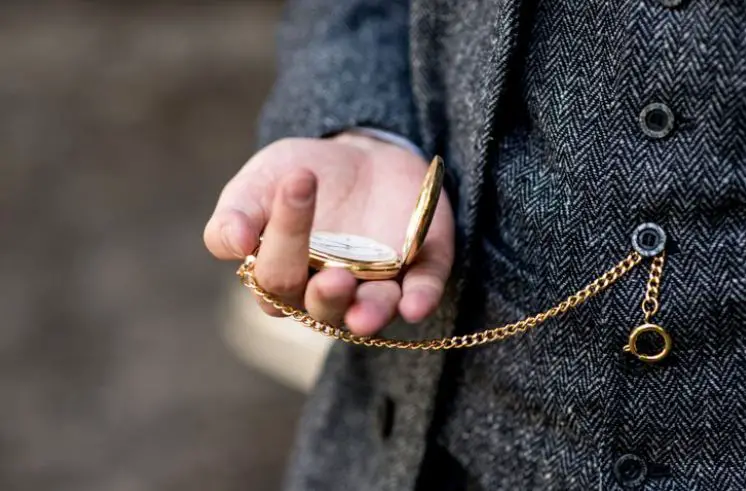
Using a pocket watch is different from a wristwatch, but once you get the hang of it, it can add a fresh touch to your style and routine.
Let’s break down how to wear and handle yours.
Wearing Styles: Waistcoat, Trouser Pocket, Lapel
You can wear your pocket watch in a few classic ways. The waistcoat pocket is the traditional spot, with the chain hooked to a buttonhole.
If you don’t wear a vest, the trouser pocket works well.
Clip the chain to your belt loop or waistband so the watch stays secure. Another option is the lapel of your jacket, especially with shorter chains.
Try out different spots and see what feels comfortable and looks good to you.
Proper Etiquette for Formal and Casual Wear
For formal events, a pocket watch adds a touch of polish. Pair it with a suit or waistcoat and keep the chain neat and in place.
When you check the time, open the cover smoothly and close it gently. For casual wear, you can be more relaxed, wear it with jeans or casual jackets.
Just avoid noisy chains or flashy pieces if you want a subtle look.
How to Wind and Set a Pocket Watch
Winding your watch keeps it running smoothly. If it’s mechanical, wind it daily by turning the crown until you feel resistance, but don’t force it.
To set the time, pull the crown gently and turn it to adjust the hands. If your watch has a cover, open it first so you can see the dial.
Getting familiar with these steps will make your pocket watch feel like second nature.
Coordinating with Outfits and Accessories
Think of your pocket watch as part of your outfit, not just a tool. Choose chains and cases that match your other accessories, like your belt buckle, cufflinks, or watch strap.
Gold with brown leather, silver with black, and so on. It works great with classic clothing, but can also add character to modern looks.
Experiment and find what suits your style.
Collecting Pocket Watches
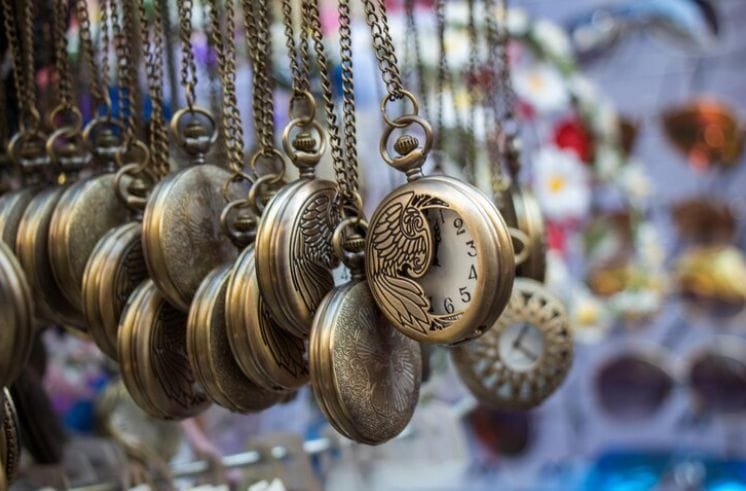
If you’re thinking about collecting pocket watches or just curious why people do, it helps to know what draws folks to these classic timepieces.
Let’s dig into what makes collecting them interesting and how you can spot watches worth your attention.
Why People Collect Them: History, Craftsmanship, Rarity
You might collect pocket watches because each one tells a story. They capture history and show skillful craftsmanship. Some are rare finds, made in limited numbers or with special features.
Holding a pocket watch connects you to a time when watches were made by hand with care.
It’s more than just owning a watch, it’s about appreciating the past and the art of watchmaking.
What Makes a Pocket Watch Valuable
Value comes from different things you can look for. Condition matters, scratches or broken parts lower the price.
The movement inside, especially if it’s mechanical and well-made, adds worth. Materials like gold or silver cases make a difference, too.
Limited editions, unique designs, and brand reputation raise value.
Knowing these details helps you find watches that hold their worth or even grow in value over time.
Tips for Identifying Antique and Vintage Watches
When you spot a pocket watch, check for signs it’s truly old or vintage. Look at the case for hallmarks or stamps that show metal quality or origin.
Study the dial and hands, older watches may have Roman numerals or delicate designs.
Open the back if you can safely, and see the movement; engraved serial numbers can help date the watch.
Researching these details online or with a guidebook helps you separate genuine antiques from newer pieces.
Reputable Brands to Collect: Waltham, Elgin, Patek Philippe
Certain brands stand out in the world of pocket watches. Waltham and Elgin made millions of reliable American watches that collectors still seek.
Patek Philippe is a name you’ll hear often for top-quality Swiss watches with fine craftsmanship and high prices.
Other brands to watch for include Hamilton, Longines, and Omega.
Knowing which names matter helps you make smart choices as you build your collection.
Maintenance and Care
Taking care of your pocket watch helps it keep working well and looking good.
A little attention goes a long way, whether your watch is new or a family heirloom.
Let’s go over what you need to do to keep your timepiece ticking.
Cleaning and Storing Your Pocket Watch
You want to keep dust and dirt away from your watch. Use a soft cloth to wipe the case regularly and avoid harsh chemicals.
When you’re not wearing it, store it in a dry, cool place like a watch box or pouch.
Avoid leaving it near magnets or strong sunlight, as these can affect the movement and fade the dial.
Servicing Intervals and What to Expect
Mechanical pocket watches need regular checkups. You should have yours serviced every three to five years.
A watchmaker will clean, oil, and adjust the parts so everything runs smoothly. Quartz models need less frequent servicing, but battery changes are important.
Don’t wait until your watch stops working to get it checked.
Preserving Value Over Time
If you want your pocket watch to keep its value, handle it with care. Keep original parts intact and avoid unnecessary repairs.
Document any service history if you have it, as this shows the watch was well cared for.
Keeping the original box or paperwork adds to its worth, especially for collectors.
Common Issues and How to Avoid Them
Watch out for moisture, which can cause rust inside your pocket watch. Always close the cover if it has one, and avoid dropping or banging it.
If you notice the watch running fast or slow, it might need cleaning or adjustment. Ignoring problems can lead to costly repairs, so stay on top of any changes in performance.
Frequently Asked Questions
Are pocket watches still practical today?
Yes, pocket watches remain practical for those who appreciate classic style and craftsmanship. While less common than wristwatches, they offer unique elegance and a vintage charm.
How long does a mechanical pocket watch last?
With proper care and regular servicing, a mechanical pocket watch can last decades, even generations, making it a durable heirloom and a timeless piece.
Can you wear a pocket watch casually?
Absolutely! Pocket watches can complement casual attire, adding vintage flair. Pair them with jeans and a vest or jacket for a stylish, distinctive everyday look.
How do I know if my pocket watch is valuable?
Check the brand, age, condition, materials, and movement. Rare, well-preserved watches from renowned makers usually have higher value. Professional appraisals can confirm worth.
Conclusion
The pocket watch remains a timeless accessory that blends rich history, intricate craftsmanship, and distinct style.
Though overshadowed by wristwatches, it holds a unique charm, reflecting personal taste and tradition.
Whether worn at formal events or treasured as an heirloom, the pocket watch offers a ritualistic experience absent in modern timepieces.
With styles ranging from classic hunter cases to transparent skeleton designs, it suits collectors and fashion enthusiasts alike.
Its enduring appeal lies in the thoughtful way it’s carried and revealed, making it more than just a tool; it’s a meaningful statement of heritage and individuality in today’s fast-paced world.
References
Pyo Merez is a men’s lifestyle enthusiast and writer about the gentleman’s place and impact on society. Raised by a distinguished gentleman dad, he offers unique insights into how the mind of a gentleman works and how societal norms shape gentlemen’s identity and vice versa.
Through his insightful articles, Pyo taps into the depths of gentleman culture to provide perspectives on etiquette and manners in modern society.

